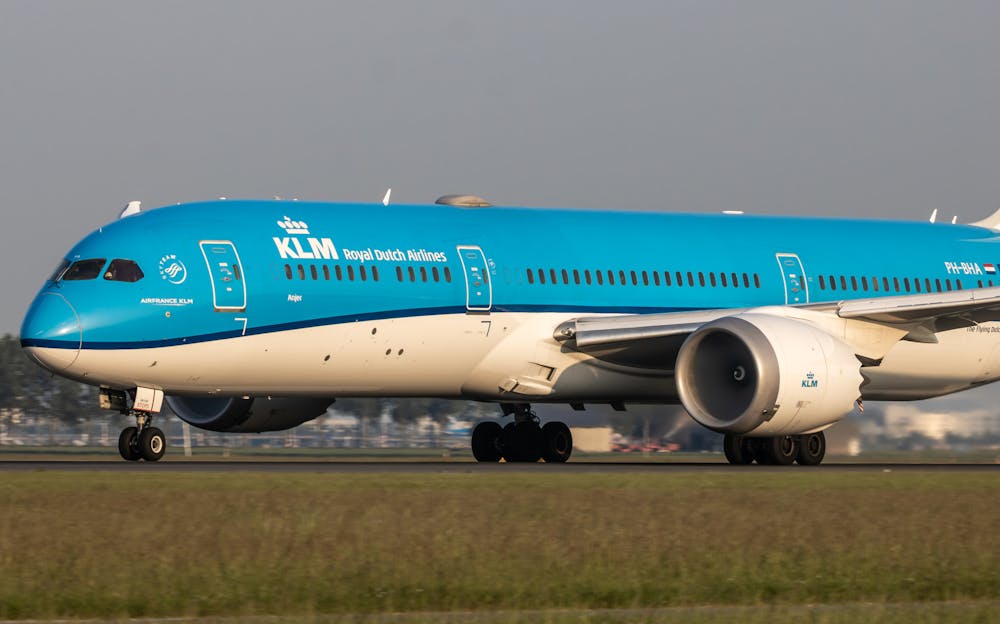
As I am sitting on a park bench facing the runway at Amsterdam Airport Schiphol, the ground begins to shake. About two miles away, at the other end of the runway, one of KLM Royal Dutch Airlines’ many Boeing 787-9 airplanes begins to push 1.2 tons of air past its engines every second as it lifts over five hundred thousand pounds of fuel, cargo and passengers off the ground. In roughly thirteen hours, it will touch the earth once again on a similar runway outside of Kuala Lumpur, Malaysia. As the plane thunders down the runway, the roar of the fan blades overpowers the sound of my camera’s shutter, as I gather as many photos as I can in the few short seconds it spends on the runway.
This particular airplane and I are well acquainted. Each airplane carries with it a unique registration code that identifies it, much like a license plate on a car. Prior to these few seconds in Amsterdam, I had photographed it in San Francisco, Houston and New York City. As it lifts off the runway and begins its journey across the Eurasian continent, the photos I capture join the nearly one hundred thousand others I have taken over the years at airports around the world.
On another occasion, across the Atlantic Ocean at Washington, D.C.’s Dulles International Airport, I sat on one of those slanted seats common at airports across the world. My flight back home to Arkansas did not depart for another six hours, and I wasn’t even in the right terminal. Across the departure hall was the largest passenger aircraft currently flying: the Airbus A380. It donned the distinctive gold lettering of the world-renowned Emirates brand, and I watched as hundreds of passengers filed into lines, preparing to spend thirteen hours being transported from chilly D.C. to Dubai’s seaside desert. As boarding concluded, a group of late arrivals clad in Ecuadorian and Mexican soccer jerseys chattered excitedly about the World Cup matches awaiting them at the end of their journey in Doha, all the while marveling at the enormity of the airplane they were approaching. I couldn’t help but share in their excitement, never mind that my flight home to Arkansas would take place on a considerably smaller airplane, departing six hours later on the other side of the airport.
The technological aspects of flight are no doubt impressive, but as a student of international affairs, what fascinates me is aviation as a concrete representation of how people and economies across the world are interconnected. At its most basic level, air routes exist where people and cargo want to go and thus can provide a small snapshot of global migration at any moment in time. Over the seven years I have spent photographing airplanes, I’ve become familiar with some of the fascinating quirks of the global movement of people and goods through the air.
For example, I discovered that, until this summer, Air Senegal operated its only US flights as a stopover service between Dakar, New York City and Baltimore. I asked myself, why Baltimore? I came to learn that New York City and the Greater Baltimore area have very large populations of people with Senegalese ancestry.
I was also curious as to why several cargo airlines operated daily flights between Colombia, Ecuador, Miami and Amsterdam. Why these destinations, and why so frequently? As it turns out, Miami and Amsterdam are the two major hubs of the global fresh flower trade, with sufficient demand for several of the largest cargo airliners in the world to deliver hundreds of tons of flowers each day. If you’ve surprised your significant other with a bouquet of flowers native to South America, there’s a chance it took a ride on one of these planes.
While it’s true that navigating airports is one of the most common stressors in modern life, I find a unique sense of peace within the cavernous architecture of international airports. Within these halls, hundreds of thousands of people transfer through an innumerable combination of arrivals and departures that span virtually every country on Earth. Whether it’s arriving several hours early for every flight or sitting on a bench across from the runway, the airport allows for a temporary reprieve from the other stressors of student life. There are no exams, no final papers and no deadlines–just me, my camera and whatever airplanes may happen by. During a particularly stressful midterm season in the heat of my first year at Hopkins, I took the MARC train down to D.C. to watch the endless volley of American Airlines planes navigate over the Potomac River.
Even at the lowest of travel nightmares, such as spending a birthday trapped at the Dublin airport due to a delayed arrival, or landing in an entirely different state due to overwhelming winds in my hometown, I can’t help but feel a deep peace when surrounded by this wonder of modern life. While I have fallen victim to my fair share of stressful mechanical issues, bad weather and their corresponding cancellations and delays, I encourage all to stop by an airport sometime soon and marvel at the majesty of it all.
In just over a century, a world once separated by days of travel over land and sea has been shrunk down to mere hours, shooting through the sky at around 500 miles per hour. Much is to be done, of course, about the acute sustainability problems of burning massive amounts of jet fuel to achieve this connectivity, but as an on-the-ground observer, I will forever owe a special peace to an afternoon spent watching these giant tubes of aluminum arrive and depart from airports around the world.
Daniel Quezada is a senior from Rogers, Arkansas majoring in International Studies.





